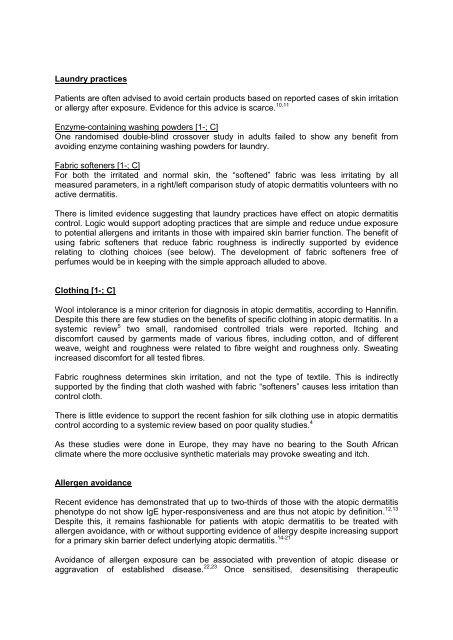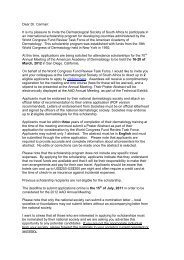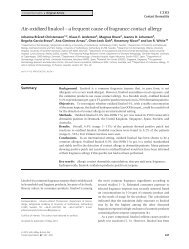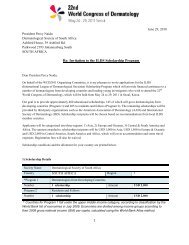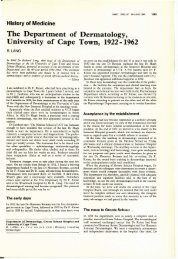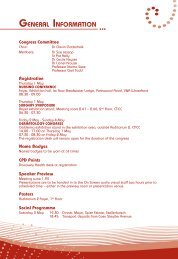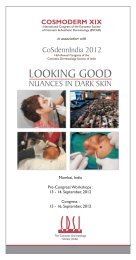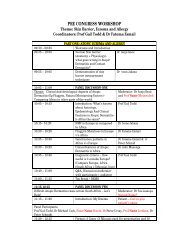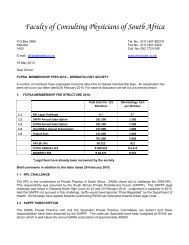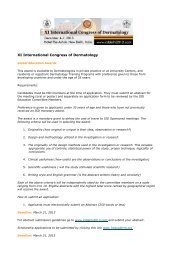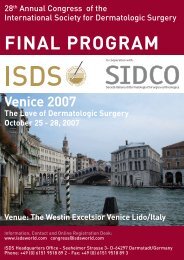Guidelines on the Management of Atopic Dermatitis ... - Dermatology
Guidelines on the Management of Atopic Dermatitis ... - Dermatology
Guidelines on the Management of Atopic Dermatitis ... - Dermatology
You also want an ePaper? Increase the reach of your titles
YUMPU automatically turns print PDFs into web optimized ePapers that Google loves.
Laundry practices<br />
Patients are <strong>of</strong>ten advised to avoid certain products based <strong>on</strong> reported cases <strong>of</strong> skin irritati<strong>on</strong><br />
or allergy after exposure. Evidence for this advice is scarce. 10,11<br />
Enzyme-c<strong>on</strong>taining washing powders [1-; C]<br />
One randomised double-blind crossover study in adults failed to show any benefit from<br />
avoiding enzyme c<strong>on</strong>taining washing powders for laundry.<br />
Fabric s<strong>of</strong>teners [1-; C]<br />
For both <strong>the</strong> irritated and normal skin, <strong>the</strong> “s<strong>of</strong>tened” fabric was less irritating by all<br />
measured parameters, in a right/left comparis<strong>on</strong> study <strong>of</strong> atopic dermatitis volunteers with no<br />
active dermatitis.<br />
There is limited evidence suggesting that laundry practices have effect <strong>on</strong> atopic dermatitis<br />
c<strong>on</strong>trol. Logic would support adopting practices that are simple and reduce undue exposure<br />
to potential allergens and irritants in those with impaired skin barrier functi<strong>on</strong>. The benefit <strong>of</strong><br />
using fabric s<strong>of</strong>teners that reduce fabric roughness is indirectly supported by evidence<br />
relating to clothing choices (see below). The development <strong>of</strong> fabric s<strong>of</strong>teners free <strong>of</strong><br />
perfumes would be in keeping with <strong>the</strong> simple approach alluded to above.<br />
Clothing [1-; C]<br />
Wool intolerance is a minor criteri<strong>on</strong> for diagnosis in atopic dermatitis, according to Hannifin.<br />
Despite this <strong>the</strong>re are few studies <strong>on</strong> <strong>the</strong> benefits <strong>of</strong> specific clothing in atopic dermatitis. In a<br />
systemic review 5 two small, randomised c<strong>on</strong>trolled trials were reported. Itching and<br />
discomfort caused by garments made <strong>of</strong> various fibres, including cott<strong>on</strong>, and <strong>of</strong> different<br />
weave, weight and roughness were related to fibre weight and roughness <strong>on</strong>ly. Sweating<br />
increased discomfort for all tested fibres.<br />
Fabric roughness determines skin irritati<strong>on</strong>, and not <strong>the</strong> type <strong>of</strong> textile. This is indirectly<br />
supported by <strong>the</strong> finding that cloth washed with fabric “s<strong>of</strong>teners” causes less irritati<strong>on</strong> than<br />
c<strong>on</strong>trol cloth.<br />
There is little evidence to support <strong>the</strong> recent fashi<strong>on</strong> for silk clothing use in atopic dermatitis<br />
c<strong>on</strong>trol according to a systemic review based <strong>on</strong> poor quality studies. 4<br />
As <strong>the</strong>se studies were d<strong>on</strong>e in Europe, <strong>the</strong>y may have no bearing to <strong>the</strong> South African<br />
climate where <strong>the</strong> more occlusive syn<strong>the</strong>tic materials may provoke sweating and itch.<br />
Allergen avoidance<br />
Recent evidence has dem<strong>on</strong>strated that up to two-thirds <strong>of</strong> those with <strong>the</strong> atopic dermatitis<br />
phenotype do not show IgE hyper-resp<strong>on</strong>siveness and are thus not atopic by definiti<strong>on</strong>. 12,13<br />
Despite this, it remains fashi<strong>on</strong>able for patients with atopic dermatitis to be treated with<br />
allergen avoidance, with or without supporting evidence <strong>of</strong> allergy despite increasing support<br />
for a primary skin barrier defect underlying atopic dermatitis. 14-21<br />
Avoidance <strong>of</strong> allergen exposure can be associated with preventi<strong>on</strong> <strong>of</strong> atopic disease or<br />
aggravati<strong>on</strong> <strong>of</strong> established disease. 22,23 Once sensitised, desensitising <strong>the</strong>rapeutic


